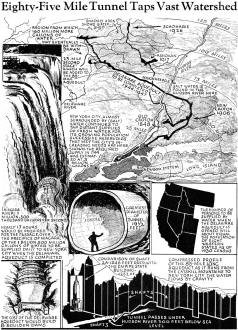| August 1937 Popular Mechanics |
 [Table of Contents] [Table of Contents]
Wax nostalgic about and learn from the history of early
mechanics and electronics. See articles from
Popular Mechanics,
published continuously since 1902. All copyrights hereby acknowledged.
|
A few weeks ago, a stack
of about 60 issues of vintage Popular Mechanics, Mechanix Illustrated, and Popular
Science magazines were discovered at an estate sale for $20. An equivalent cache
on eBay would cost around $120-$150 plus shipping. Although a lot of the content
does not pertain to electronics, it is all technology related and I figure a much
will be of interest to RF Cafe visitors. This piece from the August 1937 issue
of Popular Mechanics is a prime example. It was the intracacy and complexity
of the line drawings that caught my attention. Shown is the very extensive scheme
devised to supply New York City with an abundant water supply. The Delaware Aqueduct,
when complete, would supply 1.5 billion gallons of water to residents and businesses.
The anticipated cost was $272 million, which in 2023 money is equivalent to
$5.736 billion (a 2100% inflation in 86 years). That's probably about what
a similar current-day project would cost. What is really profound about the undertaking
is the scale of everything and that such huge holes and tunnels could be excavated
back then, as well as the enormousness of the water control valves, and the machines
needed to control them. The point where supply pipes enter the city are 500 feet
below sea level, running under the Hudson River. Keep in mind the people who achieved
this and so many other colossal feats of engineering and construction when you hear
or read about groups of agitators who claim to have built the modern world while
disparaging those who really got the job done - with many being killed or maimed
in the process. Don't let you kids be taught otherwise in school.
|
Giant Tube to Supply Water for Ten Millions

New York's $272,587,000 Delaware aqueduct, designed to supply
ten million persons with water within ten years, is begun with driving of a shaft,
fourteen feet in diameter, which pierces a mountain. Upper left, note how use of
water increased as price dropped. Other drawings show features of the shaft which
will tap the water supply in a giant tunnel. Massive concrete construction will
protect water system from bombs dropped by enemy planes.
|
Eighty-Five Mile Tunnel Taps Vast Watershed

Tapping a vast watershed, the huge tunnel will convey by gravity
one and one-half billion gallons of water each day from the Catskill mountains to
New York, a distance of eighty-five miles. The greatest diameter of the tunnel will
be nineteen and one-half feet. In map at ,top, note various sources which have been
tapped and spot from which 160 million gallons more per day may be drawn when the
population warrants such an extension.
|
Posted August 10, 2023
|





























